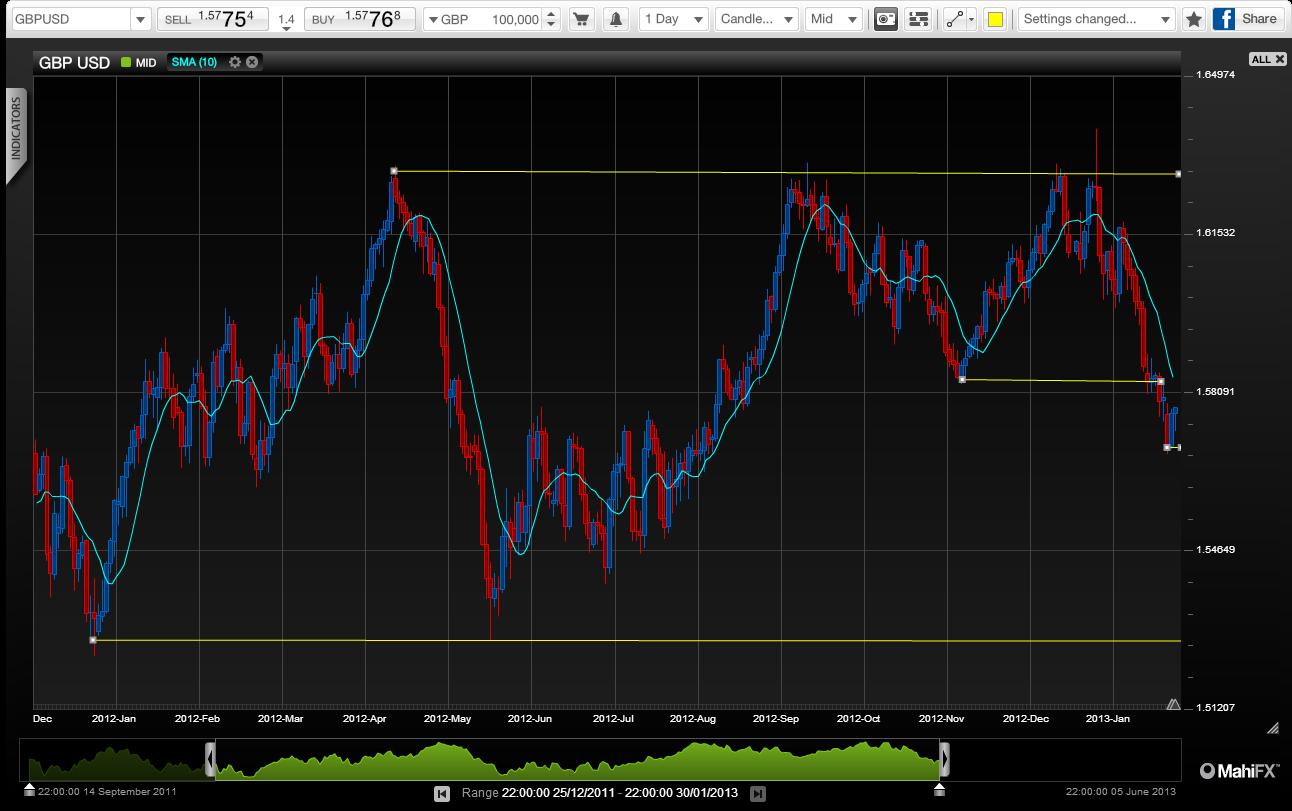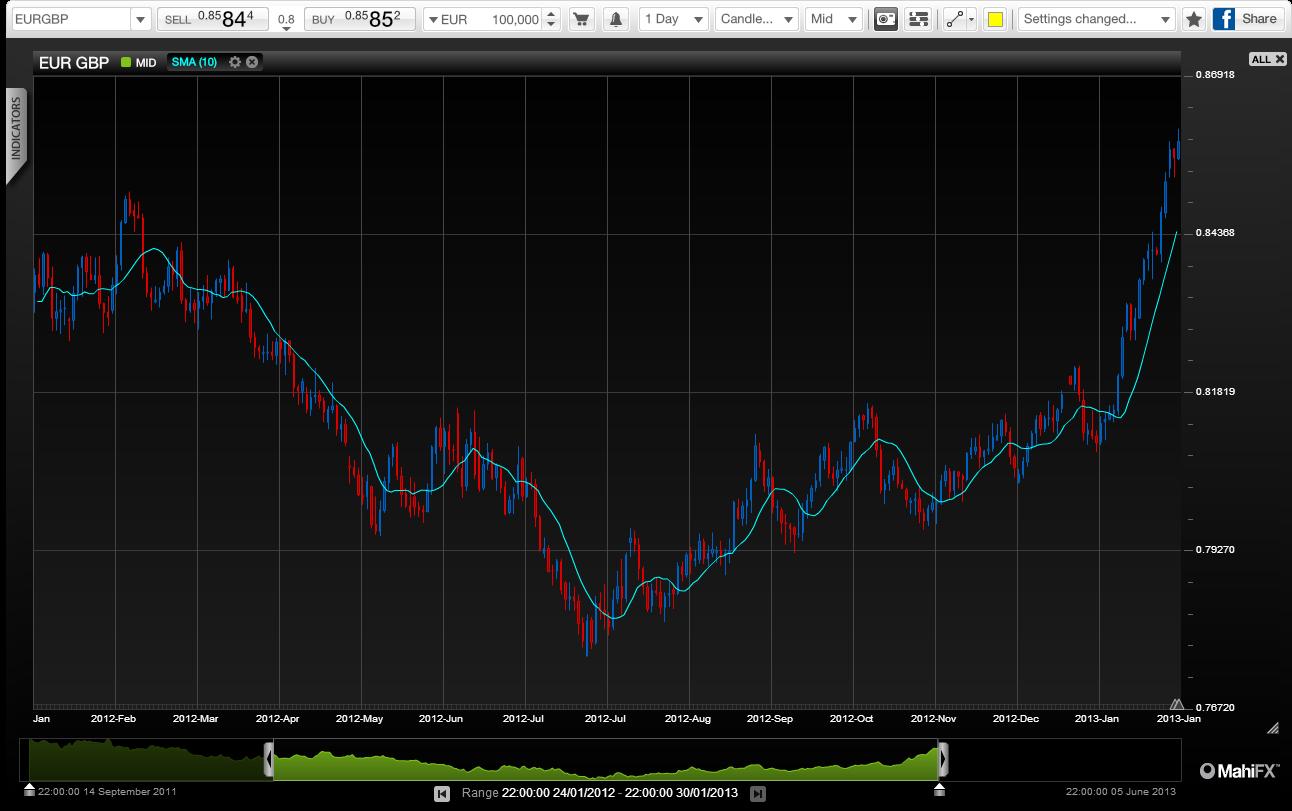What's to love about the British pound (GBP)? Not much. The U.K. has an economy that can't recover for any length of time, credit rating downgrades are almost a dead certainty and worst of all there's a risk of a vicious downward spiral if investors lose confidence.
If it wasn't for the fact that much of the rest of the world looks pretty bleak, there probably would have been a run on GBP a while ago. Such are the scale of the U.K.'s economic woes that GBP may now replace JPY as the dog currency on forex markets over the coming months.
It is quite possible that GBP/USD will be test support around 1.5400-1.5350, levels last seen in the Summer of 2012. Over the longer-term, if few improvements show up, GBP/USD could even break through 1.4000, last pierced in 2009. Worryingly for GBP the current risk-off rally driving equity markets seems to have passed it by completely despite being seen as a 'risk' currency. The next catalyst for GBP/USD could come as early as Friday, Feb. 1 with the release of U.S. non-farm payrolls. A good number is likely to be bullish for the U.S. dollar.
Q4 U.K. GDP actually fell 0.3% and there are a number of technical arguments to suggest the decline isn't as bad as it looks, but overall 2012 was a weak year for the British economy as have been the last five years. But, a weak domestic economy often is compensated by a fall in the value of the currency — that's happened in the UK with declines of 25%-30% — followed by a pick-up in exports and less imports. That rebalancing hasn't happened and the U.K.'s current account deficit is now around 3.5% of GDP, compared with 1.3% in 2011.
So in effect trade is subtracting from the U.K. economy and if the current account deficit carries on worsening, not only will it weigh on growth, but it is bound to have a depressing impact on GBP. A lower GBP also will feed inflation via energy and food imports, so would further dent already hard pressed consumers with earnings growth around 1.5% and inflation at about 2.7%. And going by recent form, there probably won't be any dramatic pick-up in exports on GBP weakness either, though it should provide some help.
GBP/USD chart

Too much Europe
In terms of the U.K.'s trade performance one of the problems seems to be its heavy dependence on Europe. Accounting for the Rotterdam effect — where U.K. goods are shipped to world markets via North European ports — Europe absorbs just over 40% of U.K. trade. The impact of austerity measures in peripheral Eurozone countries have naturally led to declines in import volumes with Spain for instance shifting from persistent large current account deficits to steady surpluses. This is mirrored by the U.K.'s current account deficit with EU countries doubling to 4.5% in just five years. So in a sense, GBP, and the U.K. in particular, is a victim of these savage austerity programmes across much of the Eurozone.Meanwhile, the U.K.'s trade with the non-EU world saw a 65% rise for goods exported and a 35% increase in services sold abroad between 2006-2012, so the dependence on European markets is slowly diminishing in favour of emerging market countries, North America and Australasia.
The other factor hampering the U.K.'s cherished rebalancing toward exports and investment is the fact that it's manufacturing base has withered to just over 12% of GDP, though that is slowly recovering. However, manufactured goods contribute just over half of the U.K.'s exports with aerospace and automotive performing particularly well. By contrast, in Germany manufacturing accounts for about 20% of GDP and therefore that country makes a broader range of products to offer on world markets. Indeed, growth areas driven by emerging markets ranging from infrastructure related goods, machine tools through to luxury items have not benefited the U.K. nearly as much as Germany because of the former's much smaller industrial base. Many emerging market countries have not yet grown to levels of prosperity where they require services — an area the U.K. is strong in.
EURGBP chart

Some reasons for optimism
But it's not all doom and gloom. The U.K.'s unemployment rate has been falling and stands at 7.7%, despite cuts in the number of public sector workers. The other factor is that the U.K. has a flexible economy and there is a growing number of start-ups across the country spurring innovation, job creation and should contribute to economic growth.GBP's fall against the euro may help exports to healthier parts of the Eurozone, but what's really needed is a recovery in demand in countries such as Spain, Italy and even France and there are tentative signs that some peripheral Eurozone economies might be close to bottoming out.
But whilst this painful rebalancing of the economy takes place, GBP is likely to see prolonged spells of weakness, punctuated by sharp relief rallies in what is otherwise probably a long-term bear market.
Recommended Content
Editors’ Picks
EUR/USD edges lower toward 1.0700 post-US PCE

EUR/USD stays under modest bearish pressure but manages to hold above 1.0700 in the American session on Friday. The US Dollar (USD) gathers strength against its rivals after the stronger-than-forecast PCE inflation data, not allowing the pair to gain traction.
GBP/USD retreats to 1.2500 on renewed USD strength

GBP/USD lost its traction and turned negative on the day near 1.2500. Following the stronger-than-expected PCE inflation readings from the US, the USD stays resilient and makes it difficult for the pair to gather recovery momentum.
Gold struggles to hold above $2,350 following US inflation

Gold turned south and declined toward $2,340, erasing a large portion of its daily gains, as the USD benefited from PCE inflation data. The benchmark 10-year US yield, however, stays in negative territory and helps XAU/USD limit its losses.
Bitcoin Weekly Forecast: BTC’s next breakout could propel it to $80,000 Premium

Bitcoin’s recent price consolidation could be nearing its end as technical indicators and on-chain metrics suggest a potential upward breakout. However, this move would not be straightforward and could punish impatient investors.
Week ahead – Hawkish risk as Fed and NFP on tap, Eurozone data eyed too

Fed meets on Wednesday as US inflation stays elevated. Will Friday’s jobs report bring relief or more angst for the markets? Eurozone flash GDP and CPI numbers in focus for the Euro.